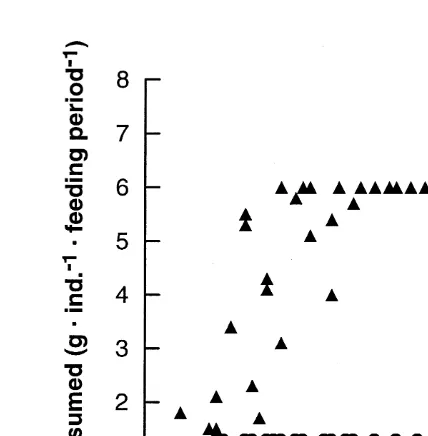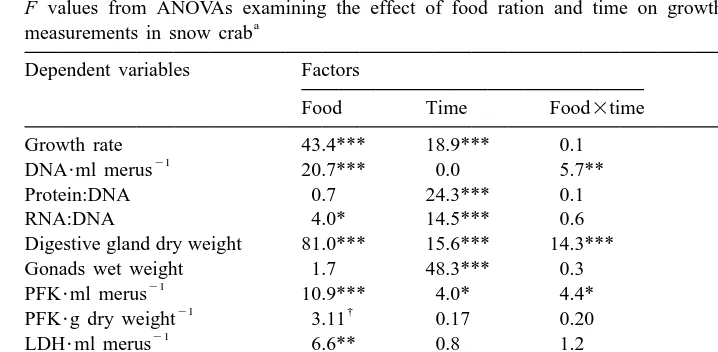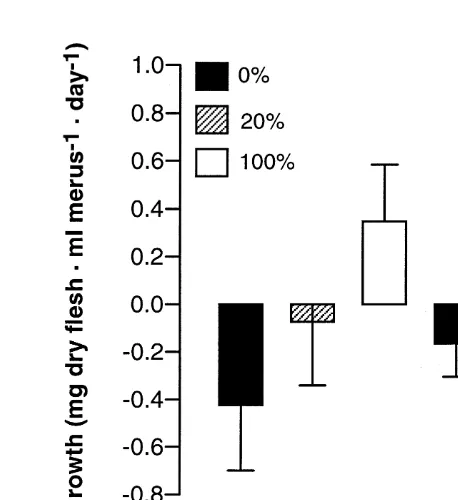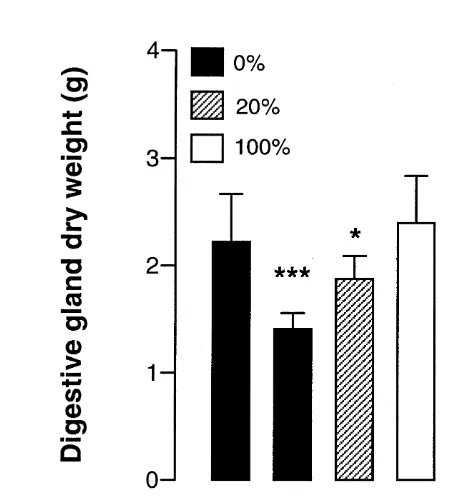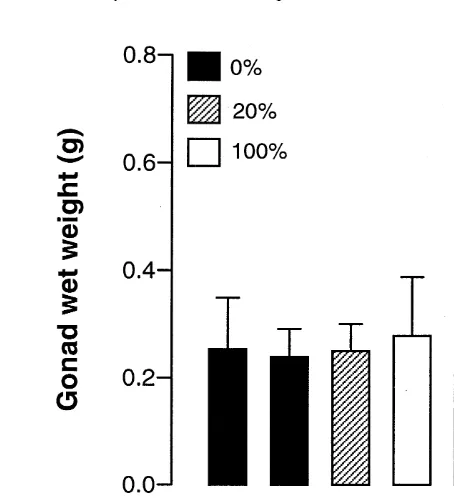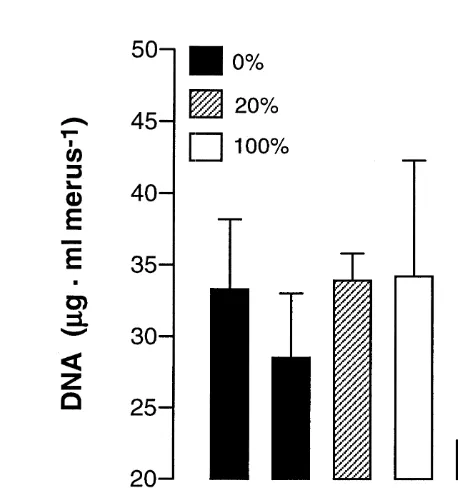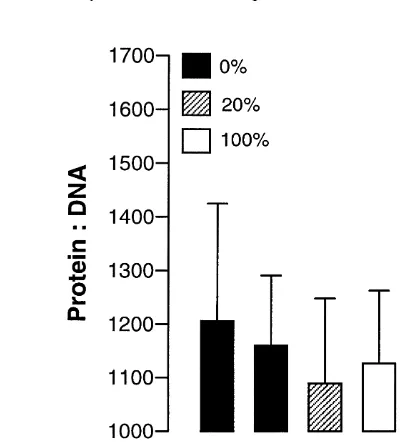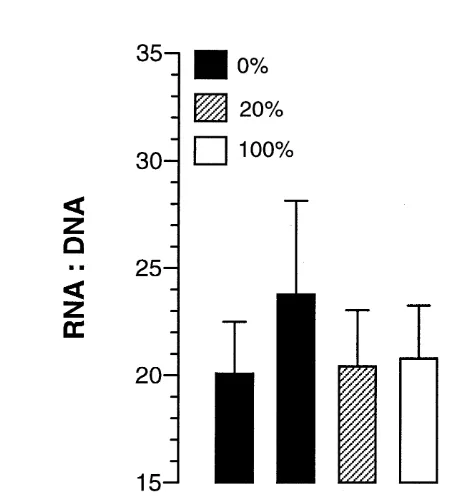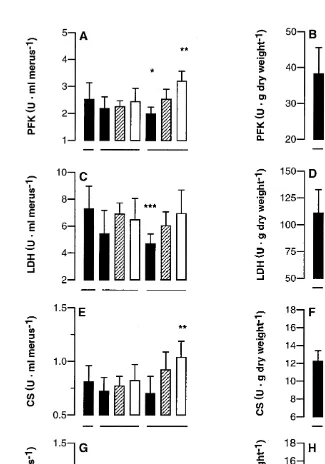L
Journal of Experimental Marine Biology and Ecology 243 (2000) 95–113
www.elsevier.nl / locate / jembe
Changes in muscle of postmoult snow crabs Chionoecetes
opilio (O. Fabricius) fed different rations
a ,* b a
Elise Mayrand , Jean-Denis Dutil , Helga Guderley
a
´ ´ ´
Departement de biologie, Universite Laval, Quebec, Canada, G1K 7P4
b
` ˆ ´
Ministere des Peches et des Oceans, Institut Maurice-Lamontagne, 850 route de la Mer, C.P. 1000,
´
Mont-Joli, Quebec, Canada, G5H 3Z4
Received 2 February 1999; received in revised form 28 June 1999; accepted 27 July 1999
Abstract
Somatic growth, muscle cell condition and metabolism, and gonadal production have been
21 21
studied in male snow crabs Chionoecetes opilio fed 0, 0.4 and 2 g?animal ?day and sampled 5, 25, and 60 days after the terminal moult. Twenty-five days after moulting, muscle growth rate was low in crabs fed a high ration and negative in the other groups, and no gonadal production took place. This suggests that the energy was utilised in priority to sustain a high maintenance metabolism. Between 25 and 60 days post-moult, maintenance costs were apparently lower and more energy was directed, in decreasing order of priority, towards gonadal production, which was independent of food ration, muscle growth and reserve build-up in the digestive gland, the two latter being directly related to food ration. Starvation caused the death of merus muscle cells, as indicated by the significant decrease in DNA content, but after 60 days the size of the remaining cells (protein:DNA ratio) had increased as much as that of crabs fed a high ration. It may be a better strategy to maintain fewer cells, by using material and energy obtained from the sacrificed ones, than to keep all cells in a deficient state. Crabs fed a high ration filled the new larger exoskeleton through hypertrophy and hyperplasia. After 25 days of undernutrition, the reduced number of muscle cells relatively to the merus volume was counterbalanced by an enhanced activity of phosphofructokinase (PFK), citrate synthase (CS) and cytochrome C oxidase (CCO) per g of muscle dry weight. An inverse relationship between food ration and enzyme activity per g dry weight further attenuated the effect of food ration on the enzyme total activity in the whole merus muscle. After 60 days of starvation, the still high enzyme activity per g dry weight could no longer compensate for the continuing loss of cells and, at that time, the enzyme total activity was directly related to food ration. Our results suggest that the feeding status of wild crabs may affect their locomotor ability through effects on muscle capabilities. 2000 Elsevier Science B.V. All rights reserved.
´
*Corresponding author. Present address: Elise Mayrand, Universite de Moncton, Campus de Shippagan, 218 Boul. J.D. Gauthier, Shippagan, Nouveau-Brunswick, Canada, E8S 1P6. Tel.: 3425; fax: 506-336-3477.
E-mail address: [email protected]. (E. Mayrand)
Keywords: Chionoecetes opilio; Food; Growth; Metabolism; Postmoult
1. Introduction
Crustacean growth has been mainly quantified by increases in carapace size (Colby and Fonseca, 1984; Robichaud et al., 1989; Paul and Paul, 1995, 1996; Sainte-Marie et al., 1995). However, carapace enlargement is only a step in the growth trajectory. Numerous biochemical process take place during the postmoult period, leading to changes in somatic and gonadal mass. Immediately after ecdysis, the animals have a very soft carapace and a reduced muscular mass. This is a critical time when crabs have a limited capacity to walk and eat and are vulnerable to predation (O’Halloran and O’Dor, 1988; Chang, 1995; Freire, 1996; West, 1997). How the muscle mass is increased and how the metabolism of muscle is adjusted during this period is thus of interest.
Few studies have examined physiological events in muscle of postecdysial crusta-ceans. Following ecdysis, muscles must grow to produce the larger forces required by the larger exoskeleton. Thus, the size and the number of muscle cells, as well as their capacity to synthesise proteins and ATP, are likely to increase during the course of the postecdysial period. Indeed, Skinner (1966) reported a marked increase in the rate of amino acid incorporation into proteins in the chela muscle of Gecarcinus lateralis, between 6 and 25 days postmoult. The addition of new sarcomeres, lengthening of existing ones, and transverse and longitudinal splitting of myofibrils have been identified as mechanisms underlying muscle growth in crustaceans (El Haj et al., 1984; El Haj and Whiteley, 1997; Whiteley and El Haj, 1997; West, 1997). O’Connor (1968) reported that lipid is stored in the abdominal muscle of premoult Orconectes virilis, probably to facilitate membrane synthesis during muscle growth following ecdysis.
In nature, marine crabs may go through periods of food shortage and may strongly compete for food (Scheibling, 1984; Wolff and Cerda, 1992; Wolff and Soto, 1992; Lovrich and Sainte-Marie, 1997). Our knowledge of the effects of undernutrition on crustacean muscle growth and of the possible role of energy reserves in sustaining muscle growth is limited. Houlihan et al. (1990) reported that k , the fractional rate ofs protein synthesis, in leg muscle of Carcinus maenas starved for 7 days was not significantly different from that of continuously fed animals, but these authors did not take the net rate of protein synthesis into account. Wang and Stickle (1986) noted a significant decrease in RNA and DNA concentrations of whole juvenile Callinectes
sapidus, in response to starvation. They argued that the decrease in DNA concentration
muscle growth has not been assessed. In male C. opilio, germinal growth and reproductive activities seem to be costly enough to divert some energy from somatic growth, as the puberty moult leads to a smaller carapace size increment than that observed in immature males (Sainte-Marie et al., 1995).
Many questions concerning the muscle growth after moulting remain unanswered. Is muscle growth done in priority or do other events such as gonadal development take place first? By which process does muscle grow: through an increase in the number of cells, in the cell size, or both? How does food availability affect muscle growth? Is there a metabolic strategy that allows crabs to carry out all the transformations required in the postmoult period even in conditions of prolonged undernutrition? Such information would help understanding the physiology of the moult cycle as well as the effect of food availability on the fitness of wild crabs.
In an attempt to improve our knowledge of these matters, we investigated the effect of time and food ration on somatic growth, the condition and metabolic capacity of muscle cells and gonadal production in Chionoecetes opilio (O. Fabricius), following moulting. We measured the DNA content, RNA:DNA ratio, protein:DNA ratio and activity of glycolytic and mitochondrial enzymes, respectively as indicators of muscle cell number, capacity for protein synthesis (McMillan and Houlihan, 1988), cell size (Barron and Adelman, 1984) and capacity for the glycolytic and oxidative production of ATP. Tissue growth was followed by assessing the changes in muscle content of the merus (dry weight / volume) over the experimental period.
2. Materials and methods
2.1. Animals
Eighty seven male snow crabs were captured in the St. Lawrence Estuary, in
September 1993. Animals with similar carapace width (mean width 54.163.2 mm) were
selected to avoid a size effect on the biochemical variables. Indeed, body mass and maturity have been shown to affect the metabolic capacity of muscle in Chionoecetes
opilio (Mayrand et al., 1998). The crabs were held in 1.2 m31.8 m tanks, with a water depth of 0.35 m at the drain level. The tanks were supplied with natural seawater filtered
by a flow-through system removing particles down to 20 mm. The temperature and
salinity conditions were kept constant at 28C and 30 ppt. The animals were fed ad lib. with frozen shrimp and capelin, twice a week, until they moulted. Moulting began on December 10, 1993 and ended on February 21, 1994, with a survival rate of 85%. Fifty-four of the 74 crabs having successfully moulted were adult, as determined by the chela height to carapace width ratio (Conan and Comeau, 1986), while 20 were still adolescents. Following the terminology proposed by Sainte-Marie et al. (1995), adult males are defined as crabs with spermatophores and differentiated chelae, and adoles-cents as crabs with spermatophores and undifferentiated chelae. The mean carapace
width for adults was 66.263.1 mm. The adult crabs were individually tagged and
2.2. Experimental conditions
As soon as they moulted, newly adult crabs were transferred to the experimental tanks. Tanks and experimental conditions were similar to those described in the previous
section, except for the temperature which was 38C. Recently moulted individuals were
held in baskets floating in the experimental tanks for the first few days, to avoid cannibalism by crabs whose shell had already hardened. Crabs in tank A were not fed.
21 21
Those in tank B were fed with 0.4 g?animal ?d of frozen shrimp and capelin, which
represents about 20% of the quantity of food ingested by crabs fed ad lib. This is about 0.35% of the crab’s live weight and is similar to the amount of food consumed daily by 21 21 ˆ
wild C. opilio (Brethes et al., 1984). Crabs in tank C were fed with 2 g?animal ?d ,
which approximates the quantity of food ingested by crabs fed ad lib. In the following text, these food rations will be referred to as 0%, 20% and 100%. The food was distributed to the animals twice a week and, before each feeding, the shrimp and capelin remaining from the preceeding feeding were retrieved and weighed. This procedure allowed us to evaluate the mean quantity of food that was ingested by the animals during the course of the experiment
2.3. Dissection
Ten unfed animals were sampled 5 days after they had moulted, to assess the initial status of the animals. Twenty-one crabs which had had access to food rations of 0%, 20%, or 100% were sampled 25 days after moulting. Twenty-three more crabs were sampled 60 days after moulting. The number of crabs in the experimental groups ranged from 6 to 10.
Carapace width, chela height and body mass were measured. To estimate merus volume, we cut out the merus of the first left walking leg and slowly slid it into a 50 ml graduated cylinder filled with 30 ml of sea water, taking care that no air bubbles escaped from the merus before measuring the final volume. All the walking legs were cut open and muscles were removed. The total mass of wet muscle in the merus of the first left walking leg was noted. Muscles were then chopped and mixed together before sub-samples of approximately 1 g each were taken for determination of enzyme activities, nucleic acid concentrations, total protein, and water content. The sub-samples for biochemical analyses were immediately frozen in liquid nitrogen and later transferred to
2808C. The digestive gland and gonads were dissected, drained and weighed.
Intra-tissular water content in muscle and the digestive gland was measured as weight lost by
drying at 608C during 48 h. Since the gonads of many animals were too small to
determine their dry weight, the wet weight was used.
2.4. Biochemical analyses
Approximately 30 mg of frozen muscle were homogenised in an ice cold buffer
solution of imidazole 50 mM, MgCl 2 mM, Na EDTA 5 mM,Triton 0.1% and reduced2 2
glutathione 1 mM in glycerol 40% (V/ V), at pH 7.5, with a dilution 1:10 (W/ V). The
homogenates were then centrifuged at 1000 g for 10 min, at ,48C. All enzymatic
activities were measured in duplicate at 108C, using a Beckman DU-600
spec-trophotometer coupled with a circulating refrigerated water bath. Citrate synthase (CS, E.C.4.1.3.7), cytochrome C oxidase (CCO, E.C.1.9.3.1), phosphofructokinase (PFK, E.C.2.7.1.11) and lactate dehydrogenase (LDH, E.C.1.1.1.27) were measured.
The DNA content and enzyme activity (international units: mmole of substrate
converted to product per minute) were expressed per ml of merus. This form of expression was chosen because it corrects for the slight differences in merus volume among the animals and gives an indication of the DNA content or the enzyme activity in the whole merus muscle. This is interesting for interpreting the data from a mechanical point of view, as the number of cells per merus, the enzyme activity per cell and the extra- and intra-tissular water content are taken into account. Enzyme activity was also expressed per g of dry muscle as an indicator of the tissular metabolic capacity, independent of the variations in intra-tissular water content.
2.5. Growth rate
Muscle content in merus (MC) was estimated as the dry weight (mg) of total muscle tissue in the merus of the first left walking leg divided by the volume of this merus (ml). The growth rate (G) was determined for each crab by one of the following equations, depending on the time they were sacrificed after moulting:
Individual MCday 25 at ration X2mean MCday 5 at ration 0%
]]]]]]]]]]]]]]] Gday 25 – day 55 Number of days
Individual MCday 60 at ration X2mean MCday 25 at ration X
]]]]]]]]]]]]]]] Gday 60 – day 255 Number of days
Forty-four growth rates were obtained.
2.6. Statistical analysis
Normality and homoscedasticity were tested using Lilliefors’ and Bartlett’s tests, respectively. To meet these requirements, all variates, except G, had to be log
21
transformed or square root transformed (DNA?ml merus ). Time (25 and 60 days) and
Fig. 1. Food consumption per meal in adult male snow crab. Circles: crabs fed a 20% ration; triangles: crabs fed a 100% ration.
3. Results
3.1. Food consumption
The crabs began feeding soon after moulting (Fig. 1). Ten days after moulting, the 21 21 animals fed with a 20% ration were eating the entire ration, i.e. 0.4 g?animal ?day . By day 15, the crabs fed with a 100% ration occasionally ate all the available food, i.e. 2
21 21
g?animal ?day . By day 30, the maximal amount of food was consistently consumed.
3.2. Growth rate
21 21
Somatic growth rate ranged from 20.732 to 0.911 mg dry flesh?ml merus ?d .
Table 1
F values from ANOVAs examining the effect of food ration and time on growth rate and physiological a
Digestive gland dry weight 81.0*** 15.6*** 14.3***
Gonads wet weight 1.7 48.3*** 0.3
for growth rate (not transformed) and DNA?ml merus (square root transformed). The results of Tukey’s a
posteriori comparisons are given in the corresponding figures, except for enzyme activities which are given in
the Results section.
3.3. Digestive gland and gonads
The total digestive gland dry weight was significantly affected by food ration and time, as well as by the interaction of these factors (Table 1, Fig. 3). At day 25, the digestive gland dry weight gradually increased with food ration, while at day 60 there was no significant difference between food ration 0 and 20%. In crabs starved or fed a low ration, the digestive gland weight decreased from day 25 to day 60, while it rose in crabs fed 100%. The digestive gland was heavier in the reference group than in crabs starved or fed a low ration for 25 and 60 days. Only the animals fed a 100% ration for 60 days had a heavier digestive gland than the reference group (t-test).
The gonad wet weight did not change with feeding status (Table 1, Fig. 4). Our results clearly indicate that, under these experimental conditions, this variable increased from day 25 to 60, whether the animals were fed or not. All the experimental groups sampled at day 60 had a significantly higher gonad wet weight than the reference group.
3.4. Muscle cells
Fig. 2. Effects of food ration and time on the growth rate of adult male snow crab. Food ration: 0%,20%,100%. Time: day 25,day 60 (Tukey’s test).
ration 100%. The DNA content in the reference group was lower than that in the group fed 100% for 60 days and higher than that in the group starved for 60 days. The size of cells, expressed as the protein:DNA ratio, varied only with time (Table 1, Fig. 6). Starved as well as fed crabs had higher protein:DNA ratios at day 60 than at day 25. While the protein:DNA ratio remained quite constant from day 5 to day 25, it had risen sharply by day 60, although only the value for crabs fed 100% was significantly higher than that in reference crabs.
The RNA:DNA ratio, an index of the cellular machinery available for protein synthesis, was greater at day 60 than at day 25 (Table 1, Fig. 7). Food ration also had a significant effect: the RNA:DNA ratio was higher in unfed crabs than in those fed 20%. By day 60, all the experimental groups had a higher RNA:DNA ratio than the reference group.
3.5. Enzymatic capacity
The metabolic capacity of the whole merus muscle, as represented by enzyme activity per ml of merus, increased with food ration either at day 25 and 60 (LDH and CS) or only at day 60 (PFK and CCO), as shown in Table 1 and Fig. 8a, c, e, g. In contrast, the activity of the four enzymes, expressed per g of dry weight, was inversely related to food ration (Table 1 and Fig. 8b, d, f, h), although the effect of food ration on PFK and
Fig. 3. Effects of food ration and time on the digestive gland dry weight of adult male snow crab. At ration 0%: day 25.day 60; at ration 20%: day 25.day 60. At day 25: ration 0%,20%,100%; at day 60: (ration 0%520%),100% (Tukey’s test). Experimental group differs from the day 5 group: * p,0.05, ** p,0.01, *** p,0.001 (t-test).
Time did not have such so strong an effect as food ration since only the CS activity per ml of merus, for food rations 20% and 100%, and that of PFK, for the 100% ration, were lower at day 25 than at day 60. On the other hand, CCO and LDH activities per g of dry weight were higher at day 25 than at day 60 (Table 1 and Fig. 8).
Significant differences were also noted between the reference and some of the experimental groups. After 60 days of starvation, the glycolytic (PFK and LDH) and mitochondrial (CCO) capacities per ml of merus were weaker than they were 5 days after moulting. On the contrary, 60 days after moulting, crabs fed 100% showed higher PFK and CS activities per ml of merus than the reference group. The LDH and CCO activity per g of dry weight were lower in the groups fed a 20% and a 100% ration for 60 days than in the reference group. The LDH activity in crabs fed 100% for 25 days and the CCO activity in crabs fed 20% for 25 days were also lower.
4. Discussion
4.1. Allocation of energy
Fig. 4. Effects of food ration and time on gonad wet weight of adult male snow crab. Time: day 25,day 60 (Tukey’s test). Experimental group differs from the day 5 group: * p,0.05, *** p,0.001 (t-test). varies with the time elapsed since moulting. During the first weeks following ecdysis (day 5 to 25), the energy expenditure for maintenance metabolism seemed to be high, as somatic and gonadal production were at their lowest (Figs. 2 and 4). Unfed crabs and crabs fed a low ration intensively mobilised the reserves from the digestive gland, as shown by the pronounced diminution in its dry weight (Fig. 3). The digestive gland of crustaceans is the primary organ for reserve storage. These reserves can be drawn upon whenever the energetic demands exceed the input of energy (Passano, 1960; Heath and Barnes, 1970). The role of this organ is particularly important during post-moult. For example, the chitin which is used to build the new endocuticle is mainly derived from the glycogen stock of the digestive gland (Vonk, 1960). Variations in the size of the digestive gland, as observed in our study, would thus reflect the equilibrium between energy expenditure and input. Unfed crabs and crabs fed a low ration also drew energy from the muscle, as the negative growth rate of muscle in the merus suggests. In crustacean muscle, glycogen and lipids are generally generally mobilised first when energy is needed, but proteins can also be catabolised (Vinagre and DaSilva, 1992). O’Connor (1968) reported that lipid is stored in the abdominal muscle of premoulting
Fig. 5. Effects of food ration and time on DNA content per ml of merus in adult male snow crab. At ration 0%: day 25.day 60; at ration 100%: day 25,day 60. At day 60: ration 0%,20%,100% (Tukey’s test). Experimental group differs from the day 5 group: * p,0.05 (t-test).
In contrast, during the period from day 25 to 60, the energy demands for the maintenance metabolism seemed to be lower than during the weeks that immediately followed moulting. Indeed, growth rate was higher (Fig. 2), reserves were stored in the digestive gland of crabs fed a high ration (Fig. 3) and gonadal production took place in all groups including the unfed crabs (Fig. 4). Why the animals fed with a 20% ration relied more heavily on the digestive gland reserves during the second experimental period while they could have used this source of energy more extensively during the first experimental period and thus have spared muscle tissue is not clear.
Fig. 6. Effects of food ration and time on the protein:DNA ratio of adult male snow crab. Time: day 25,day 60 (Tukey’s test). Experimental group differs from the day 5 group: * p,0.05 (t-test).
1995), during which endocuticle thickness can increase by 7mm a day (Skinner, 1962,
1985). All these processes are energy consuming. A temporal sequence of events thus seems to exist after ecdysis. During the day 5 to 25 period, the energy obtained from reserves and / or food would be allocated in priority to carapace thickening and tissular reorganisation, leaving less energy for muscle growth. During the day 25 to 60 period, the decreasing order of priority would be: (1) gonadal production, (2) muscle growth if a minimal amount of food is available, and (3) accumulation of reserves in the digestive gland if the animals have access to a high ration.
Fig. 7. Effects of food ration and time on the RNA:DNA ratio of adult male snow crab. Food ration: ration 0%.20%. Time: day 25,day 60 (Tukey’s test). Experimental group differs from the day 5 group: * p,0.05, *** p,0.001 (t-test).
wild crabs and experimental ones have comparable gonad weight, even if wild crabs have presumably access to less food.
4.2. Muscle cell condition
Our results clearly demonstrate that muscle cells are lost under conditions of 21
prolonged starvation, as DNA?ml merus decreased in crabs starved for 60 days.
cells may have been transferred to the remaining ones. It may have been physiologically more important for the animals facing a severe food shortage to maintain fewer normal muscle cells rather than a large number of deficient ones. This hypothesis contrasts with the general idea that crustacean muscle cells should be conserved during starvation to allow rapid recovery when food becomes available (Wang and Stickle, 1986).
21
The changes in DNA?ml merus that were observed in the present study (Fig. 5)
may reflect changes in muscle fibers and / or in myosatellite cell number. In vertebrates, striated muscular tissue is composed of multinucleated fibres and of myosatellite cells, which are small spindle-shaped cells lacking sarcomeres (Campion, 1984). Myosatellite cells are thought to be responsible for the addition of nuclei to existing muscle fibres and for the formation of new fibres (Akster, 1983; Campion, 1984; Koumans et al., 1994; Akster et al., 1995; Matschak and Stickland, 1995). The few studies on crustaceans indicate that myosatellite cells are also present in this group (Midsukami, 1981; Skinner,
´ ´
1985; Novotova and Uhrık, 1992; Pearce et al., 1997). Thus, we can hypothesise that myosatellite cells play a key role in supporting the considerable growth of muscle after moulting.
The increased protein:DNA ratio and DNA content per ml of merus observed in crabs fed 100% during 60 days suggest that both hypertrophy and hyperplasia help fill the larger exoskeleton following moulting. For snow crabs of similar size to those we
studied, moulting leads to an increase of 25.0%66.9 in carapace width (unpublished
data), which is a considerable augmentation in volume (width increases by a factor of
1 3
1.25 while volume increases by a factor of 1.25 ). Muscle fibres have to lengthen to fill the greater distance between the apodeme and the cuticle and also have to fill a wider space. Crustacean muscle fibres can grow in width by the addition of new myofibrils and by longitudinal splitting and enlargement of existing myofibrils. They can elongate by serial addition of sarcomeres and by transverse splitting of sarcomeres (Govind, 1982; El Haj et al., 1984; El Haj and Whiteley, 1997; West, 1997). The hypothesis of growth by the addition or enlargement of myofibrils is supported by the rise in protein:DNA ratio, which was observed at day 60 independently of food ration. However, the maximal volume of individual muscle fibres is probably limited since, at day 60, the protein:DNA ratio reached what seems its maximal value (Fig. 6). The production of new fibres through fusion of myosatellite daughter cells was thus probably necessary to fill the remaining space, as suggested by the rise in DNA content in crabs fed with a 100% ration during 60 days (Fig. 5).
Our results suggest that there is a general tendency to compensate for a reduced number of muscle cells, relative to the size of the merus, by having high glycolytic and mitochondrial tissular capacities. Such a relative reduced number of cells occurred either because muscle growth had not begun to fill the new larger carapace, as in the reference group, or because some of the cells had died, as in starved crabs. These groups generally had higher enzyme activities per g of dry muscle (Fig. 8b, d, f, h) than crabs in pre-moult stages D to D fed ad lib. and kept in similar conditions of temperature and2 4 salinity. In pre-moult animals, the activity per g of dry weight was 23.78 units66.38 for
PFK, 110.99627.38 for LDH, 8.8161.35 for CS, and 6.2861.63 for CCO (unpublished
h), counterbalanced the relatively low number of muscle cells in the merus of starved crabs and crabs fed a 20% ration. This lead to an attenuation of the effect of food ration on the enzyme total capacities in the merus muscle during the 25 days immediately following ecdysis, as shown by the enzyme activity per ml of merus (Fig. 8a, c, e, g). Sixty days after moulting, the compensatory effect described above was no longer sufficient to counterbalance the continuing loss of muscle cells in starved crabs, and the effect of food ration on the enzyme activities per ml of merus became more pronounced (Fig. 8a, c, e, g). The enzyme total activity in muscle of fasting crabs no longer compared with that of fed animals, the loss of cells being too important to be compensated for by the high enzyme activity per g of dry muscle. Consequently, the total PFK, LDH and CCO capacities in merus muscle of starved crabs, as represented by the activity per ml of merus, fell below the values observed at day 5. In contrast, animals fed a 100% ration had an enhanced total metabolic capacity in the merus muscle, PFK and CS activities per ml of merus reaching higher values than those in the reference group (Fig. 8a, e). This was achieved by the addition of muscle cells rather than an increased specific tissular activity, since the enzyme activity per g of dry weight tended to return to lower values (Fig. 8b, d, f, h). This decrease in the tissue metabolic capacity with an increasing food ration may be related to a dilution effect by the storage of energy reserves in muscle of fed crabs and / or to the fact that these animals no more needed to maintain a high specific metabolic capacity since the muscle cells were now abundant. Our observations contrast with those reported for fish. A positive relationship between LDH and PFK activity per g of wet muscle and food consumption has been noted in sablefish (Sullivan and Somero, 1983), barred sand bass (Lowery et al., 1987), and cod (Dutil et al., 1998). For comparative purposes, we expressed the enzyme activities per g of wet weight, but we still found that enzyme activities were either unrelated (PFK, LDH, CS), or inversely related (CCO) to food ration, despite the fact
that water % was lower in crabs fed a high ration than in starved ones (82.01%60.74
and 84.41%60.50, respectively). Enzyme adjustments which counterbalance a loss of
cells thus seem to be a particularity of crustaceans.
The feeding status of wild crabs is likely to affect their locomotor ability via modifications of muscle capacities. Since well fed crabs had a higher metabolic capacity in the whole merus muscle and probably had a larger cross sectional area of muscle due to the more numerous cells, they may have a better locomotor ability than those starved for 60 days. Thus, the nutritional state of wild crabs would modify their fitness. Well fed crabs would forage more efficiently than undernourished ones, and would thus obtain more food. Such a positive feedback has been proposed for fish (Sullivan and Somero, 1983; Pelletier et al., 1993). The fact that snow crab kept at 38C began feeding as early as four or five days after moulting (Fig. 1) is in contrast with the observations of
O’Halloran and O’Dor (1988) who report that C. opilio held at 88C did not eat during
the first two weeks following ecdysis. This indicates that, in nature, recently moulted C.
opilio may have the physical ability to eat earlier than what is generally believed,
In conclusion, some of the events that follow moulting in C. opilio, such as gonadal development and net protein synthesis in muscle cells, seem to be chronologically determined rather than to be influenced by the feeding status of the animals. Others, such as the production of new muscle cells, changes in glycolytic and mitochondrial capacities in the merus muscle, and the reserve build-up in the digestive gland appear to be affected by both time and food ration. Cellular and metabolic adjustments may counterbalance the effect of the feeding status on the whole merus muscle metabolic capacity.
Acknowledgements
´
We are grateful to Mr. Mario Peloquin and Mrs. Claudie Vigneault for their technical
´ `
help. This work was supported by funds from the Universite Laval, from the Ministere
ˆ ´
des Peches et des Oceans, Canada, and from the Natural Sciences and Engineering Research council, Canada.
References
Adiyodi, R.G., 1985. Reproduction and its control. In: Bliss, D.E., Mantel, L.H. (Eds.), The biology of crustacea, Vol. 9, Integument, pigments, and hormonal processes, Academic Press, Orlando, pp. 147–215. Akster, H.A., 1983. A comparative study of fibre type characteristics and terminal innervation in head and axial muscle of the carp (Cyprinus carpio L.): a histochemical and electron-microscopical study. Neth. J. Zool. 33, 164–188.
Akster, H.A., Koumans, J.T.M., Cuelenaere, J., Osse, J.W.M., 1995. Uptake of tritiated thymidine in muscle of juvenile carp. J. Fish Biol. 47, 165–167.
Barron, M.G., Adelman, I.R., 1984. Nucleic acid, protein content, and growth of larval fish sublethally exposed to various toxicants. Can. J. Fish. Aquat. Sci. 41, 141–150.
Bradford, M.M., 1976. A rapid and sensitive method for the quantitation of microgram quantities of proteins utilizing the principle of protein-dye binding. Anal. Biochem. 72, 248–254.
ˆ
Brethes, J.-C.F., Desrosiers, G., Coulombe, F., 1984. Aspects de l’alimentation et du comportement alimentaire du crabe des neiges, Chionoecetes opilio (O. Fabricius), dans le sud-ouest du golfe du Saint-Laurent. Crustaceana 47, 235–244.
Campion, D.R., 1984. The muscle satellite cell: a review. Int. Rev. Cytology 87, 225–251.
Conan, G.Y., Comeau, M., 1986. Functional maturity and terminal molt of male snow crab, Chionoecetes
opilio. Can. J. Fish. Aquat. Sc. 43, 1710–1719.
Chang, E.S., 1995. Physiological and biochemical changes during the molt cycle in decapod crustaceans: an overview. J. Exp. Mar. Biol. Ecol. 193, 1–14.
Colby, D.R., Fonseca, M.S., 1984. Population dynamics, spatial dispersion and somatic growth of the sand fiddler crab Uca pugilator. Mar. Ecol. Prog. Ser. 16, 269–279.
´ ´ ¨
Drilhon, A., 1935. Etude biochimique de la mue chez les crustaces brachyoures (Maıa squinado). Ann. Physiol. Physicochimie Biol. 11, 301–326.
Dutil, J.-D., Lambert, Y., Guderley, H., Blier, P.U., Pelletier, D., Desroches, M., 1998. Nucleic acids and enzymes in Atlantic cod (Gadus morhua) differing in condition and growth rate trajectories. Can. J. Fish. Aquat. Sci. 55, 788–795.
El Haj, A.J., Whiteley, N.M., 1997. Molecular regulation of muscle growth in Crustacea. J. Mar. Biol. Ass. UK 77, 95–106.
´
Freire, J., 1996. Feeding ecology of Liocarcinus depurator (Decapoda: Portunidae) in the Rıa de Arousa (Galicia, north-west Spain): effects of habitat, season and life history. Mar. Biol. 126, 297–311. Govind, C.K., 1982. Development of nerve, muscle, and synapse. In: Atwood, H.L., Sandeman, D.C. (Eds.),
The biology of crustacea, Vol. 3, Neurobiology: structure and function, Academic Press, New York. Heath, J.R., Barnes, H., 1970. Some changes in biochemical composition with season and during the moulting
cycle of the common shore crab, Carcinus maenas (L.). J. Exp. Mar. Biol. Ecol. 5, 199–233.
Houlihan, D.F., Waring, C.P., Mathers, E., Gray, C., 1990. Protein synthesis and oxygen consumption of the shore crab Carcinus maenas after a meal. Physiol. Zool. 63, 735–756.
Kameswaramma, A.L., Shyamasundari, K., Hanumantha Rao, K., 1990. Histological and histochemical changes of the hepatopancreas in relation to moult stages of the mole crab Emerita asiatica (Milne Edwards) (Crustacea: Anomura). Riv. Idrobiol. 29, 781–796.
Koumans, J.T.M., Akster, H.A., Booms, G.H.R., Osse, J.W.M., 1993. Growth of carp (Cyprinus carpio L.) white axial muscle: hyperplasia and hypertrophy in relation to the myonucleus / sarcoplasm ratio and the occurrence of different subclasses of myogenic cells. J. Fish. Biol. 43, 69–80.
Koumans, J.T.M., Akster, H.A., Witkam, A., Osse, J.W.M., 1994. Numbers of muscle nuclei and myosatellite cell nuclei in red and white axial muscle during growth of the carp (Cyprinus carpio). J. Fish. Biol. 44, 391–408.
Lovrich, G.A., Sainte-Marie, B., 1997. Cannibalism in the snow crab, Chionoecetes opilio (O. Fabricius) (Brachyura: Majidae, and its potential importance to recruitment. J. Exp. Mar. Biol. Ecol. 211, 225–245. Lowery, M.S., Roberts, S.J., Somero, G.N., 1987. Effects of starvation on the activities and localization of glycolytic enzymes in the white muscle of the barred sand bass Paralabrax nebulifer. Physiol. Zool. 60, 538–549.
Mangum, C., 1992. Physiological aspects of molting in the blue crab Callinectes sapidus. Amer. Zool. 32, 459–469.
Matschak, T.W., Stickland, N.C., 1995. The growth of Atlantic salmon (Salmo salar L.) myosatellite cells in culture at two different temperatures. Experientia 51, 260–266.
Mayrand, E., Guderley, H., Dutil, J.-D., 1998. Effect of morphometric maturity and size on enzyme activities and nucleic acid ratios in the snow crab Chionoecetes opilio. J. Crust. Biol. 18, 232–242.
McMillan, D.N., Houlihan, D.F., 1988. The effect of refeeding on tissue protein synthesis in rainbow trout. Physiol. Zool. 61, 429–441.
Midsukami, M., 1981. The structure and distribution of satellite cells of cardiac muscles in Decapod Crustaceans. Cell Tissue Res. 219, 69–83.
´ ´
Novotova, M., Uhrık, B., 1992. Structural characteristics and distribution of satellite cells along crayfish muscle fibers. Experientia 48, 593–596.
O’Connor, J.D., 1968. Alterations in crustacean lipid metabolism during the molt cycle. Thesis, Northwestern University, Evanston, Illinois.
O’Halloran, M.J., O’Dor, R.K., 1988. Molt cycle of male snow crabs, Chionoecetes opilio, from observations of external features, setal changes, and feeding behavior. J. Crust. Biol. 8, 164–176.
Passano, L.M., 1960. Molting and its control. In: Waterman, T.H. (Ed.), The physiology of crustacea, Vol. I, Metabolism and growth, Academic Press, New York.
Paul, A.J., Paul, J.M., 1995. Changes in chela heights and carapace lengths in mature male red king crabs
Paralithodes camtschaticus after molting in the laboratory. Alaska Fish. Res. Bull. 2, 164–167.
Paul, A.J., Paul, J.M., 1996. Male Tanner crab carapace widths at previous intermolt estimated from laboratory growth. Kachemak Bay, Alaska. Alaska Fish. Res. Bull. 3, 132–135.
Pelletier, D., Guderley, H., Dutil, J.-D., 1993. Effects of growth rate, temperature, season, and body size on glycolytic enzyme activities in the white muscle of Atlantic cod (Gadus morhua). J. Exp. Zool. 265, 477–487.
Pearce, J., Krause, K.M., Govind, C.K., 1997. Muscle fibers in regenerating crayfish motor nerves. J. Neuro. Physiol. 78, 3498–3501.
´ ´ ´ ´
Robichaud, D.A., Bailey, R.F., Elner, R.W., 1989. Growth and distribution of snow crab, Chionoecetes opilio, in the southeastern Gulf of St. Lawrence. J. Shell. Res. 8, 13–23.
Sainte-Marie, B., Hazel, F., 1992. Moulting and mating of snow crabs, Chionoecetes opilio (O. Fabricius) in shallow waters of the northwestern Gulf of Saint Lawrence. Can. J. Fish. Aquat. Sci. 49, 1282–1293.
ˆ
Sainte-Marie, B.S., Raymond, Brethes, J.-C., 1995. Growth and maturation of the benthic stages of male snow crab, Chionoecetes opilio (Brachyura. Majidae).Can.J. Fish. Aquat. Sc. 52, 903–924.
Scheibling, R.E., 1984. Predation by rock crabs (Cancer irroratus) on deceased sea urchins
(Strongylocen-trotus droebrachiensis) in Nova Scotia. Can. J. Fish. Aquat. Sci. 41, 1847–1851.
Shafer, T.H., Roer, R.D., Midgette-Luther, C., Brookins, T.A., 1995. Postecdysial cuticle alteration in the blue crab, Callinectes sapidus: synchronous changes in glycoproteins and mineral nucleation. J. Exp. Zool. 271, 171–182.
Skinner, D.M., 1962. The structure and metabolism of a crustacean integumentary tissue during a molt cycle. Biol. Bull. 123, 635–647.
Skinner, D.M., 1966. Breakdown and reformation of somatic muscle during the molt cycle of the land crab,
Gecarcinus lateralis. J. Exp. Zool. 163, 115–124.
Skinner, D.M., 1985. Molting and regeneration. In: Bliss, D.E., Mantel, L.H. (Eds.), The biology of Crustacea, Vol. 9, Academic Press, New York, pp. 43–146.
Sullivan, K.M., Somero, G.N., 1983. Size- and diet-related variations in enzymic activity and tissue composition in the sablefish, Anoplopoma fimbria. Biol. Bull. 164, 315–326.
Vinagre, A.S., DaSilva, R.S.M., 1992. Effects of starvation on the carbohydrate and lipid metabolism in crabs previously maintained on a high protein or carbohydrate-rich diet. Comp. Biochem. Physio. 102A, 579–583.
Vonk, H.J., 1960. Digestion and metabolism. In: Waterman, T.H. (Ed.), The physiology of crustacea, Vol. I, Metabolism and growth, Academic Press, New York, pp. 291–316.
Wang, S.Y., Stickle, W.B., 1986. Changes in nucleic acid concentration with starvation in the blue crab
Callinectes sapidus Rathburn. J. Crust. Biol. 6, 49–56.
West, J.M., 1997. Ultrastructural and contractile activation properties of Crustacean muscle fibres over the moult cycle. Comp. Bioch. Physiol. 117B, 333–345.
Whiteley, N.M., El Haj, A.J., 1997. Regulation of muscle gene expression over the moult in Crustacea. Comp. Biochem. Physiol. 117B, 323–331.
Wolff, M., Soto, M., 1992. Population dynamics of Cancer polyodon in La Herradura Bay, northern Chile. Mar. Ecol. Prog. Ser. 85, 69–81.
